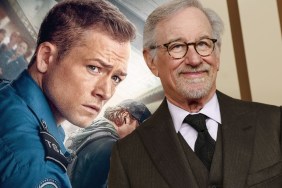Remember when it seemed like a terrible idea for Hollywood to make a big screen comedy out of 21 Jump Street? Or an animated feature film version of Cloudy with a Chance of Meatballs that bore little to no resemblance to Judi and Ron Barrett’s classic children’s book?
This Friday, Phil Lord and Chris Miller are getting ready to prove us all wrong again with their third big screen feature, The LEGO Movie, an epically scaled genre and franchise mash-up that manages to find the perfect blend of plastic pop and good old fashioned imagination.
ComingSoon.net traveled to LEGOLAND itself in Calabasas, California to speak with Lord and Miller about the long, long road they traveled (and some of the long, long green things they saw) in bringing The LEGO Movie to the big screen.
Fans of Lord and Miller’s acclaimed-but-short-lived animated series “Clone High” should also pay particular interest to the end of the interview, wherein Lord and Miller offer a shred of hope regarding a continuation of the MTV series possibly, Lord suggests, as a feature film!
CS: I guess my first question is, who told you you were allowed to do this?
Chris Miller: We just kept doing it until they forced us to stop. From the beginning, we were really skeptical of a LEGO movie, like any sane person should be. We just decided, “Well, there is a way to do it that would be kind of cool and not feel like it’s a giant commercial for toys.” Luckily, the people at Warners and those over at the LEGO group were cool with that. We were like, “Really?! You’ll let us do this? All right! At some point, someone is going to tell us we have to stop, right?” And here we are four years later!
Phil Lord: Yeah, the money ran out and now the movie’s here!
CS: The film itself also offers a meta reflection on the notion that all ideas are of value, no matter how silly or useless they seem. Was that always at the heart of what you wanted to say with the film?
Lord: I think so. I mean, a lot of our movies are sort of about that. Things can be totally ridiculous and try to be meaningful at the same time. But yeah, that was kind of always part of it.
Miller: What’s really cool about LEGOs is that you can put a bunch of bricks on the table any everybody will make something different. Everyone has different ideas and some of them may seem crazy. This guy we work with, Will, one day just built a hundred foot long green stripe. We were like, “What’s it for?” and he said, “I dunno. I just built it because I wanted to.” We were both like, “That’s pretty neat, actually!”
Lord: That green stripe was in the movie for about a year. It didn’t stick. It was replaced, basically, by the double-decker couch.
CS: The double-decker couch is exactly the sort of thing that you build as a kid.
Lord: Yeah, it’s totally spontaneous and it doesn’t really make sense.
Miller: But it’s also kind of awesome.
Lord: It’s kind of amazing and, if you were trying to make something cool, you would never make that.

CS: There’s also a message at the heart of “The LEGO Movie” about creative ownership. You’re opening up the same day as George Clooney’s The Monuments Men and, bizarrely, both films sort of touch on the same point about art belonging to the world. In the case of your film, you’re dealing with some characters that are corporate icons but, to a kid, they’re toys.
Miller: Yeah, it’s weirdly everything and nothing at the same time. We were trying to have it all ways when we were making this movie. It really was a big exposition on creativity and the ways different people work and collaboration.
Lord: And innovation. Creating the conditions for innovation, right? Because [Emmet template=’galleryview’]–> starts out in a world where it’s really top down and all the creativity is outsourced. So much so that people like Emmet don’t really think of anything. They just follow the things that are given to them. Nowadays, ever since recorded media, that’s the way a lot of people interface with art. They consume it, but they don’t create it as often. At least not as adults. A hundred years ago, you’d sit around the campfire and everyone played an instrument. So we kind of miss that stuff.
CS: The film also sort of suggests, though, that it’s alright to be part of the crowd. The opening sort of plays like the 1984 Macintosh commerical, but fun. “Everything is Awesome” is playing and there’s a reminder that even the mundane can be interesting.
Miller: We felt that it should be like Singapore. There’s an undertone that’s maybe a little bit scary, but it’s most happy and clean and everyone is smiling and having a good time.
Lord: It’s a happy totalitarian society! There’s comfort, though, in following rules and knowing your place. Knowing what you’re supposed to do.
Miller: We tried to have it both ways. Emmet is sort of a synthesis of “Instructions are helpful” as a framework or a structure. Having new innovation on top of that is what’s great about LEGO itself and great about having new ideas.
Lord: It’s funny, but the minute he falls down the hole, he’s just in pain the whole time. He’s super-comfortable and everything’s good, but the minute he encounters that piece, he has to grow into this creative guy. He’s just uncomfortable. I think there’s a truth to that.
Miller: It’s hard!
Lord: Yeah, it’s hard. It’s a pain in the butt.
CS: You’ve got a great “Clone High” reference in the film with Will Forte voicing Abraham Lincoln. I know that there are a million things to go back and catch with a pause button, but is there anything in particular you want fans to keep an eye out for?
Lord: We did put a dolphin noise in there.
Miller: Yup, there’s dolphin noise where there shouldn’t be. The animators put in all sorts of details. We were approving shots and looking at every single shot 20 times. Even in the final mix, there were things that made us go, “I never noticed that! Over in the far left corner, that thing is happening!”
Lord: We encouraged everyone to bring creativity and their own detail into every frame. It was a free for all amongst the crew.
Miller: Chris McKay, who was our co-director, oversaw all the animation.
Lord: God, he’s a real cinephile.
Miller: He’s got a lot of little things planted in there.
Lord: I’m sure there’s a Budd Boetticher reference in there somewhere.
Miller: What was cool was that we had so many different [genre scenes template=’galleryview’]–>. We had a western scene so we could an homage to western movies. We even got the guy from Ennio Morricone out of retirement to whistle on the movie. We were able to do a space epic. There was a little “Lord of the Rings” type thing. It was a mash-up of all our favorite movies.

CS: Who came up with Middle-Zealand?
Millers: That’s Phil’s joke!
Lord: Yeah, we wanted to have a big fellowship meeting for some reason. We saw it as, “Oh, this our epic quest movie!” It’s sort of “Lord of the Rings” mixed with “Time Bandits.”
CS: It’s interesting to see that kids are already familiar with the films’ characters even before the movie is released.
Lord: I know!
Miller: It’s crazy!
Lord: I hope this movie is good for kids, because they’re going to remember it. [Producer template=’galleryview’]–> Dan Lin’s kids are playing “LEGO Movie.”
Miller: My son plays “LEGO Movie”! He’s playing “LEGO Movie 2: The Sequel,” which has a lot more “Star Wars” in it, his version.
CS: Because it took so many years to see this film through to the screen —
Lord: Yeah, we made two Jump Streets during the making of this film.
CS: If you did a sequel, would it take four or five years?
Lord: I’m sure the Warners people would love for it to go faster. Hopefully it won’t take that long, but these stories are very hard to craft. Especially when anything can happen. A sequel to “The LEGO Movie” could literally star in the Civil War-era south. It could really go anywhere. Early discussions have been very wide-ranging.
CS: It seems like we live in a day and age where ensemble stories are doing very well at the box office. “The LEGO Movie” kind of fits in alongside something like “The Avengers” or “The Fast and the Furious” as far as a team-building story. Who were the first characters to make the roster?
Lord: There was a group of 13 at one point.
Miller: You know, like that great movie “The Magnificent 13.”
Lord: Or “The 13 Musketeers”.
CS: There’s an “Ocean’s 13.”
Lord: There is! And it’s the best of the series!
Miller: So we culled it down to a group of seven with two bad guys. So nine, which was plenty.
Lord: We just ran out of real estate to tell other stories. We really would like to have a few more brick-built characters. A few more characters that are a little more abstract. I think that Batman was kind of always part of the group, because we thought it would be really funny. It was a character that everybody recognized and that Warners owned. We thought we might have a chance of making a big main character. At one point, a lot of the main characters were just licensed properties that were impossible to get. Then we realized, as we started talking to some lawyers, that that was going to be a lot to hang a whole movie on. Then you might have to take one of those characters out at the last second and that would be bad. So we resolved to create our own characters and it worked out great.

CS: Well, there’s also the fact that, not all that long ago, LEGO existed without any licensed characters.
Miller: That was our original idea. There’s a construction worker and a pirate and a space guy and a knight and a wizard or something and they all go on a quest together. That was the first thing we thought. Kind of like “The Wizard of Oz” and “The Matrix” and “Lord of the Rings” combined. That pretty much was what it ended up being in the end. But we added Batman!
CS: One of the things that’s very impressive about your films is that your sense of humor is, essentially, the same regardless of whether you’re delivering a PG movie or an R.
Miller: Yeah, we’re pretty immature. It works out that adults who have similar immaturities and children all laugh at the same stuff as we do. We approach it all in the exact same way, just with more F-bombs in the R-rated films.
Lord: I wish we had fewer bad words in “Jump Street.” That would probably be better. What’s the number of curse words? It’s crazy. More than “Scarface” or something.
Miller: The airplane version of “21 Jump Street” is probably 40 minutes long.
CS: Are you consulted when its time to pull together airplane or television cuts of your films?
Miller: We did do it for “21 Jump Street.” It was actually really fun with the actors doing the TV safe stuff. We had Ice Cube in there and he was really good it. We said, “How are you so good at this?”
Lord: He said, “I’ve been doing radio edits of my songs for 20 years. I know exactly what this is.”
Miller: He was like, “You two monkey butlers get over here!” That sort of thing. It was great.
Lord: He was into it, just making it as crazy as possible. I haven’t actually seen it, but I’m dying to.
Miller: We tried to use the silliest stuff possible, because everyone already knows what’s going on. We were with Brie Larson and she was supposed to say, “I’m just f–ing with you,” and we changed it to, “I’m just flirting with you.” We tried to chance it to the funniest lines we could. Melon-farmers, mother-fathers, monkey butlers.
CS: Do you know what’s coming up next for you?
Lord: I keep talking about quitting the business. I guess, though, that if this movie does okay, I might keep going.
Miller: We just try to find stories that are interesting to us. Oftentimes they are things that are a challenge. Most of the movies that we’ve made so far seemed like a bad idea at the time. Then we go, “Wait a minute! There is a way to make this cool! We could do ’21 Jump Street’ as a comedy and have it actually be good. Challenge accepted!” Hopefully, one day we’ll do something that seems like a good idea.
Lord: At the beginning! I want to make something easy!
CS: It also feels very much like the medium isn’t a big deal for you.
Lord: I’d rather work in different styles. It was kind of fun to make “Cloudy,” which has such a stylized look and then do “LEGO” which, while it’s stylized, is also photo-real. That would have been a huge no-no on a movie like “Cloudy.”
CS: Is there any chance of you guys one day coming back and continuing or concluding “Clone High”?
Lord: I hope so. It’s expensive to get it out of MTV world and they aren’t necessarily jumping at the chance to give another company the opportunity to make money off of it.
Miller: The Ghandi hunger strike really hurt, but we see Bill Lawrence, still, from time to time. He’s a buddy. Whenever we see him we go, “Let’s figure out a way to get ‘Clone High’ back!”
Lord: Maybe a movie. I think there might be a chance for an animated movie.
Miller: We obviously have a lot of fondness for that.
Lord: Paramount is cranking up their animation division. Let’s make this happen! Silas, dude, make a few calls. Get the public behind us!
The LEGO Movie opens in theaters the evening of Thursday, February 6.
The LEGO Movie
-
The LEGO Movie

-
The LEGO Movie

-
The LEGO Movie

-
The LEGO Movie

-
The LEGO Movie

-
The LEGO Movie

-
The LEGO Movie

-
The LEGO Movie

-
The LEGO Movie

-
The LEGO Movie

-
The LEGO Movie

-
The LEGO Movie

-
The LEGO Movie

-
The LEGO Movie

-
The LEGO Movie

-
The LEGO Movie

-
The LEGO Movie

-
The LEGO Movie

-
The LEGO Movie

-
The LEGO Movie

-
The LEGO Movie

-
The LEGO Movie

-
The LEGO Movie

-
The LEGO Movie

-
The LEGO Movie

-
The LEGO Movie

-
The LEGO Movie

-
The LEGO Movie

-
The LEGO Movie

-
The LEGO Movie

-
The LEGO Movie

-
The LEGO Movie

-
The LEGO Movie

-
The LEGO Movie

-
The LEGO Movie

-
The LEGO Movie

-
The LEGO Movie

-
The LEGO Movie

-
The LEGO Movie

-
The LEGO Movie

-
The LEGO Movie

-
The LEGO Movie

-
The LEGO Movie

-
The LEGO Movie

-
The LEGO Movie

-
The LEGO Movie

-
The LEGO Movie

-
The LEGO Movie

-
The LEGO Movie

-
The LEGO Movie

-
The LEGO Movie

-
The LEGO Movie

-
The LEGO Movie

-
The LEGO Movie

-
The LEGO Movie

-
The LEGO Movie

-
The LEGO Movie

-
The LEGO Movie

-
The LEGO Movie

-
The LEGO Movie

-
The LEGO Movie

-
The LEGO Movie

-
The LEGO Movie

-
The LEGO Movie

-
The LEGO Movie

-
The LEGO Movie

-
The LEGO Movie

-
The LEGO Movie

-
The LEGO Movie










